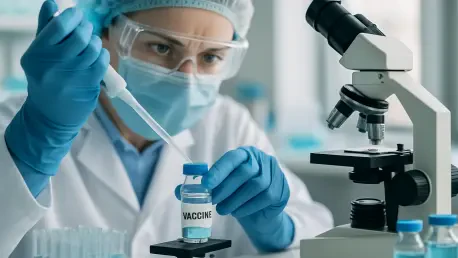During a global health crisis like the COVID-19 pandemic, the race to produce and distribute vaccines revealed a staggering reality: traditional quality control methods could delay production by days or even weeks, risking lives and stalling response efforts. This urgency has spotlighted an emerging trend in biomanufacturing—rapid vaccine quality control technologies that promise to transform how vaccines are tested and released. The ability to ensure safety and efficacy in real time is not just a technical advancement but a critical necessity for meeting global demand. This analysis delves into a pioneering tool developed through a collaboration between Purdue University and Merck & Co. Inc., explores its alignment with industry trends, highlights expert perspectives, and examines its potential to reshape pharmaceutical production.
The Emergence of Rapid Vaccine Quality Control Technology
Growth and Adoption of Process Analytical Technology (PAT)
The biomanufacturing sector is witnessing a significant shift toward Process Analytical Technology (PAT), a framework designed to monitor and control production in real time. Reports from the National Institute for Innovation in Manufacturing Biopharmaceuticals indicate that PAT adoption has surged in recent years, with many companies prioritizing tools that enhance speed and precision. This trend reflects a broader industry push to eliminate delays caused by traditional offline testing, ensuring that vaccines and biologics meet stringent quality standards without halting production lines.
This growing reliance on PAT is driven by the need to address urgent public health demands. Real-time monitoring systems allow manufacturers to detect issues instantly, reducing waste and accelerating the release of critical medical products. As regulatory bodies increasingly support PAT integration, its role in streamlining vaccine production continues to expand, setting the stage for innovations that redefine efficiency in the pharmaceutical landscape.
Real-World Application: The Purdue-Merck 30-Second Tool
A standout example of PAT in action is the Raman spectroscopy-based tool developed by Purdue University in partnership with Merck & Co. Inc. This groundbreaking technology can analyze vaccine quality in under 30 seconds, a dramatic improvement over conventional methods that often require hours or days. By using a laser to capture molecular signatures, the tool offers a nondestructive way to assess biological samples, making it ideal for continuous production environments.
One notable application of this tool is its ability to detect human cytomegalovirus (CMV) particles at industrial flow rates. CMV, a complex virus affecting vulnerable populations, presents significant challenges for vaccine development, yet this tool successfully characterized it under real-world manufacturing conditions. Such precision demonstrates its practical value, enabling manufacturers to maintain quality without sacrificing speed during high-volume production.
The implications of this technology extend beyond a single virus. Its success with CMV suggests potential adaptability to other vaccine candidates, offering a scalable solution for diverse biomanufacturing needs. This innovation exemplifies how rapid quality control can bridge the gap between laboratory research and industrial application, paving the way for faster, more reliable vaccine rollout.
Industry Perspectives on Rapid Quality Control Innovations
The significance of rapid quality control tools is echoed by leading experts involved in their development. Mohit Verma, an associate professor at Purdue University, has emphasized that traditional offline testing creates bottlenecks that slow down vaccine production. According to Verma, real-time monitoring technologies like the Raman spectroscopy tool address these delays by providing immediate feedback, ensuring consistent quality throughout the manufacturing process.
Shreya Athalye, a Purdue graduate student and co-author of the research, has highlighted the tool’s role in supporting continuous manufacturing models. Athalye notes that the ability to analyze samples in under 30 seconds eliminates the need to pause production for testing, a common issue with older methods. This efficiency not only saves time but also reduces costs, making vaccine production more accessible and sustainable for manufacturers globally.
Beyond individual insights, there is a broader industry consensus that transitioning to real-time quality control is essential for future-proofing biomanufacturing. Experts point out that while traditional testing ensures safety, its slow pace is incompatible with the rapid response required during pandemics. The adoption of innovative tools is seen as a transformative step, promising greater consistency and reliability in meeting global health challenges.
Future Horizons for Vaccine Quality Control
Looking ahead, the application of Raman spectroscopy holds immense potential beyond its current focus on CMV. Researchers are optimistic about adapting this technology to detect other viruses and biologics, broadening its impact across the pharmaceutical sector. Such versatility could position it as a universal quality control solution, capable of addressing diverse production challenges in vaccine development.
Continuous manufacturing, supported by tools like this, offers additional benefits such as cost reduction and environmental sustainability. By minimizing downtime and resource waste, this approach aligns with industry goals to create greener, more efficient production systems. However, challenges remain, including regulatory hurdles that require harmonization with existing standards and the scalability of technology to meet varying production volumes across different facilities.
A balanced perspective must also consider potential drawbacks, such as the initial costs of adopting advanced tools and training staff to operate them. While the long-term benefits of faster vaccine rollout and improved quality are clear, pharmaceutical companies may face short-term financial and logistical barriers. Addressing these issues will be crucial to ensure widespread integration of rapid quality control technologies in the coming years.
Final Reflections and Next Steps
Reflecting on this transformative trend, the journey of rapid vaccine quality control marks a pivotal moment in biomanufacturing history. The Purdue-Merck tool, with its 30-second analysis capability, stands as a beacon of innovation, aligning seamlessly with the rise of Process Analytical Technology and addressing critical production bottlenecks. Its successful application to complex viruses like CMV underscores a shift toward efficiency and reliability in vaccine development.
Moving forward, stakeholders across the pharmaceutical industry are encouraged to prioritize investment in such technologies, fostering collaborations between academia and industry to drive further advancements. Overcoming regulatory and scalability challenges demands collective effort, ensuring that rapid quality control becomes a standard practice. By embracing these solutions, the sector can build a more resilient framework, ready to meet global health demands with unprecedented speed and precision.









